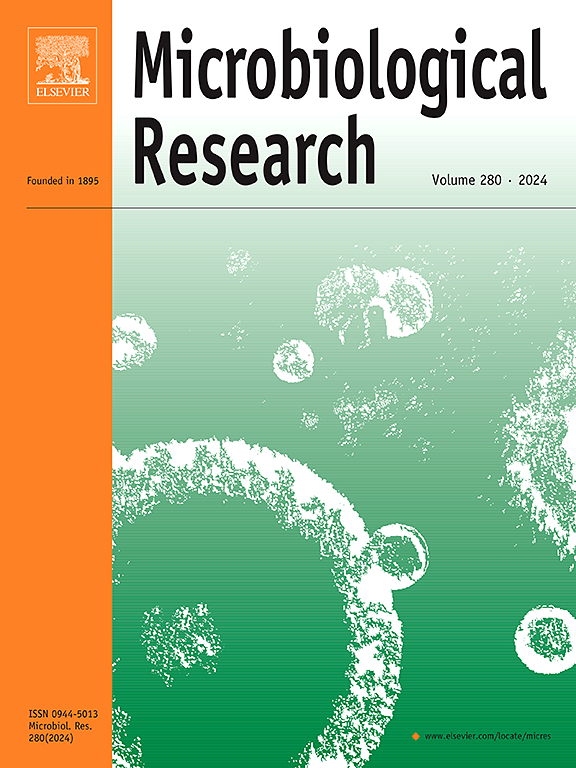利用蛋白质翻译后修饰的相互作用:增强植物对重金属毒性的抗性
IF 6.1
1区 生物学
Q1 MICROBIOLOGY
引用次数: 0
摘要
重金属(HMs)毒性发现了大量的植物健康风险,影响发芽、生长、生产力和生存。接触HMs可中断细胞功能,增加氧化应激并影响生理过程。植物产生了一系列的适应性反应,其中蛋白质在探测、信号传递和减轻金属诱导的胁迫中起着关键作用。在压力下,翻译后修饰,包括磷酸化、泛素化、糖基化和乙酰化,是蛋白质稳定性、定位和功能的重要调节因子。本文综述了PTMs在HMs应激反应中的综合分析,包括PTMs如何调节信号通路、降解途径和TFs调制。具体来说,讨论磷酸化、泛素化、泛素化、类化、脂化和s -亚硝基化在HMs胁迫下的作用,以及PTMs对抗氧化酶、应激蛋白、金属转运体和螯合物的解毒调节。这篇综述说明了PTMs的串扰,以显示协同相互作用如何调节蛋白的稳定性、活性和定位。在相声中,泛素化往往从磷酸化到随后的蛋白质降解,以及时可逆的方式触发应激反应。然而,sumoylation稳定了快速去磷酸化的关键转录因子,并在金属解毒中不可或缺,与磷酸化形成协同组合以维持其活性。阐述了未来的研究方向,重点是通过PTM工程培育出耐胁迫的植物品种。通过PTMs研究植物对HMs胁迫的响应,强调PTMs与植物抗逆性的相关性,倡导系统生物学综合方法推进植物胁迫生物学。本文章由计算机程序翻译,如有差异,请以英文原文为准。
Harnessing the interplay of protein posttranslational modifications: Enhancing plant resilience to heavy metal toxicity
Heavy metals (HMs) toxicity finds substantial plant health risk, affecting germination, growth, productivity, and survival. HMs exposure can interrupt cellular function, increase oxidative stress and affect physiological processes. Plants have developed array of adaptive responses, with proteins playing key role in detecting, signalling, and mitigating metal-induced stress. Under stress, posttranslational modifications, including phosphorylation, ubiquitination, glycosylation and acetylation, are essential regulators of protein stability, localization, and function. This review examines the comprehensive profiling of PTMs in HMs stress responses, including how PTMs regulate the signalling pathways, degradation pathways, and TFs modulation. Specifically, discuss the role of phosphorylation, ubiquitination, and sumoylation, neddylation, lipidation, and S-nitrosylation in specifically under HMs stress with PTMs regulation of antioxidant enzymes, stress proteins, metal transporters and chelators of detoxification. This review illustrates the crosstalk of PTMs to show how synergistic interactions regulate protein stability, activity, and localization upon HMs stress. In cross talk, ubiquitination often starts from phosphorylation to subsequent degradation of proteins in a timely and reversible way to trigger stress responses. However, sumoylation stabilizes key transcription factors that are rapidly dephosphorylated and integral in metal detoxification, form a synergistic combination with phosphorylation to maintain their activity. It explains the future research directions, focusing on PTM engineering to generate stress tolerant plant varieties. By studying the response of plants to HMs stress through PTMs, emphasizes the relevance of PTMs towards plant resilience and advocates for systems biology integrative approach to advancing plant stress biology.
求助全文
通过发布文献求助,成功后即可免费获取论文全文。
去求助
来源期刊

Microbiological research
生物-微生物学
CiteScore
10.90
自引率
6.00%
发文量
249
审稿时长
29 days
期刊介绍:
Microbiological Research is devoted to publishing reports on prokaryotic and eukaryotic microorganisms such as yeasts, fungi, bacteria, archaea, and protozoa. Research on interactions between pathogenic microorganisms and their environment or hosts are also covered.
 求助内容:
求助内容: 应助结果提醒方式:
应助结果提醒方式:


